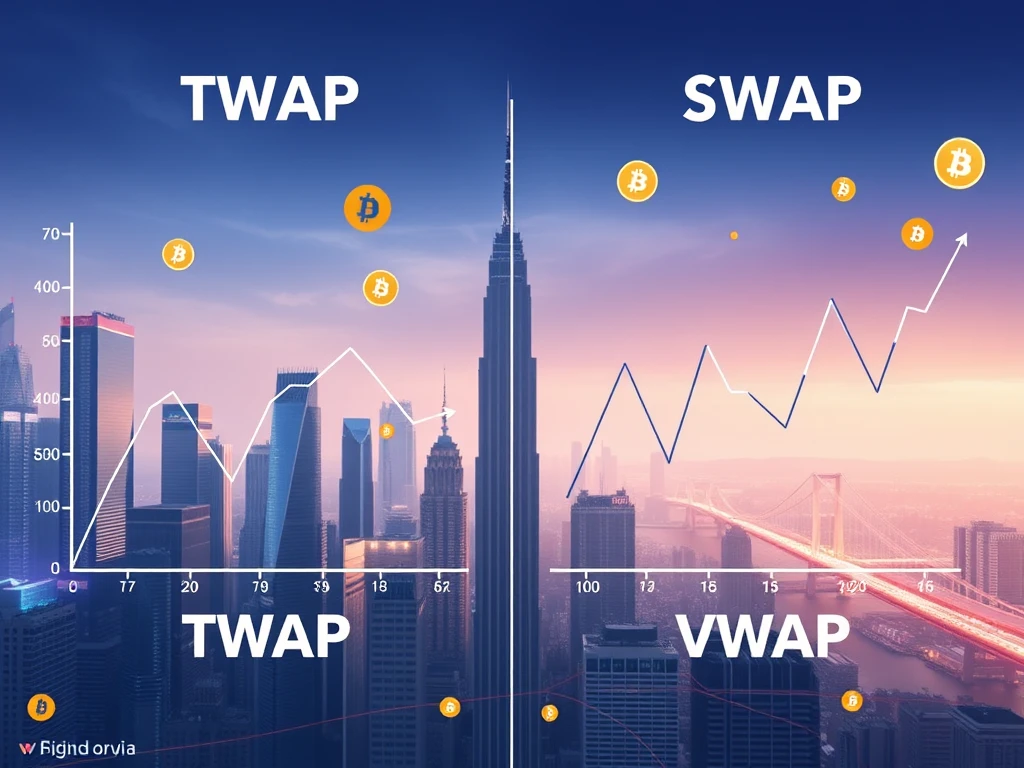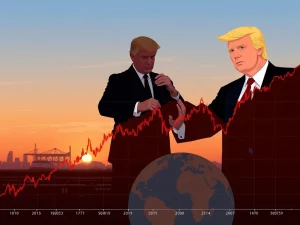TWAP vs VWAP: The Ultimate Crypto Trading Strategy Showdown

Want to trade crypto like a pro and minimize market impact? In the fast-paced world of cryptocurrency trading, execution is just as critical as prediction. Enter algorithmic trading strategies, your 24/7, emotion-free trading assistants. Among these, execution algorithms stand out, focusing on getting you in and out of positions smoothly, especially when dealing with larger orders. Two powerhouse strategies in this realm are TWAP (Time-Weighted Average Price) and VWAP (Volume-Weighted Average Price). But what exactly is the TWAP vs VWAP difference, and when should you use each? Let’s dive into this essential aspect of crypto trading!
Decoding Algorithmic Trading Strategies in Crypto
Algorithmic trading has become a game-changer for crypto traders. Imagine automating your trades based on pre-set rules, eliminating emotional decisions and human error. These algorithms operate tirelessly, scanning markets, reacting instantly to price shifts, and managing volumes far beyond human capacity. Common algorithmic trading strategies include:
- Trend Following: Capitalizing on market momentum, whether upward or downward.
- Arbitrage: Exploiting price discrepancies across different crypto exchanges for profit.
- Market Making: Providing liquidity by placing buy and sell orders, profiting from the bid-ask spread.
- Mean Reversion: Betting on prices reverting to their historical average over time.
Within algorithmic trading, execution algorithms are a specialized subset. They aren’t about predicting market direction; instead, they focus on efficient trade execution without causing significant price fluctuations. These are invaluable for discreetly handling large orders and minimizing slippage. Passive order execution strategies, like TWAP and VWAP, are key players here, aiming for a fair average price.
What is Time-Weighted Average Price (TWAP) in Crypto?
TWAP, or Time-Weighted Average Price, is a foundational and widely used execution strategy in algorithmic crypto trading. Think of it as a steady, consistent approach to executing large orders. TWAP works by breaking down your large order into smaller, equal-sized trades, distributed evenly over a chosen period. The crucial aspect? It ignores market volume fluctuations. The primary goal of TWAP is to achieve an average execution price based on time, not market activity, and to prevent large orders from causing unwanted price volatility.
When is TWAP Your Go-To Strategy?
- Quiet Execution: When you need to execute a substantial trade discreetly, without signaling your intentions to the broader market.
- Low Liquidity Environments: In markets with lower trading volume, even moderate orders can trigger price swings. TWAP helps mitigate this by pacing your trades.
The beauty of TWAP lies in its simplicity. It’s easy to grasp and implement. However, this simplicity has a trade-off. TWAP‘s disregard for trading volume means it might not be ideal during high-volatility periods or sudden market shifts. You might miss out on favorable price points or end up with an average price that doesn’t truly reflect the dynamic market conditions. In essence, TWAP excels in stable, less liquid markets where consistent, time-based execution is prioritized over volume-based optimization.
Did you know? You can easily integrate TWAP into your crypto trading on platforms like TradingView. Simply add the “TWAP” indicator to your chart.
Calculating TWAP: A Simple Formula
The TWAP calculation is straightforward. You sample the asset’s price at regular intervals, sum these prices, and then divide by the number of intervals.
Formula:
TWAP = (Price1 + Price2 + … + Pricen) / n
Example: Bitcoin (BTC) TWAP Calculation
Let’s say we monitor Bitcoin’s price every 10 minutes and record the following prices:
90,000 → 90,100 → 89,900 → 90,050
Step 1: Sum the prices:
90,000 + 90,100 + 89,900 + 90,050 = 360,050
Step 2: Divide by the number of intervals (4):
TWAP = 360,050 / 4 = 90,012.5
Therefore, the TWAP for this period is $90,012.5.
What is Volume-Weighted Average Price (VWAP) in Crypto?
VWAP, or Volume-Weighted Average Price, is a crucial metric for traders seeking a more nuanced understanding of an asset’s average price throughout a trading day. Unlike TWAP, which treats all time intervals equally, VWAP incorporates trading volume into the equation. This means prices associated with higher trading volumes have a greater influence on the final average. VWAP, therefore, provides a more accurate reflection of the price at which most trading activity occurred, making it a superior benchmark for assessing trade execution quality.
Why is VWAP a Powerful Tool?
- Benchmark for Trade Execution: Traders often use VWAP as a benchmark to evaluate their trade performance. Buying below VWAP generally indicates a better-than-average execution price compared to the broader market.
- Trend Identification: VWAP can also serve as a trend indicator. A current price above VWAP may suggest bullish market sentiment, while a price below VWAP could signal bearishness.
While VWAP offers a more precise view of market value and potential overbought or oversold conditions, it’s not without limitations. It’s more complex to calculate than TWAP and can be skewed by unusually large trades, potentially distorting the average. However, when used judiciously and in conjunction with other indicators, VWAP is an invaluable asset for traders seeking deeper insights into market dynamics.
Did you know? The concept of Volume-Weighted Average Price (VWAP) was introduced to the trading world in a 1988 academic paper, establishing it as a benchmark for institutional investors to evaluate trade execution quality.
Calculating VWAP: Factoring in Volume
VWAP calculation differs from TWAP by weighting prices based on their corresponding trading volumes. Prices with higher volume have a greater impact on the average.
Formula:
VWAP = (∑ (Pricei × Volumei)) / ∑ Volumei
This means you sum the product of price and volume for each transaction and divide it by the total volume.
Example: Bitcoin (BTC) VWAP Calculation
Consider the following Bitcoin trading data:
- $90,000 at 10 trades
- $90,100 at 20 trades
- $89,900 at 5 trades
- $90,050 at 15 trades
Step 1: Multiply each price by its volume:
- 90,000 × 10 = 900,000
- 90,100 × 20 = 1,802,000
- 89,900 × 5 = 449,500
- 90,050 × 15 = 1,350,750
Step 2: Sum the results from Step 1:
900,000 + 1,802,000 + 449,500 + 1,350,750 = 4,502,250
Step 3: Calculate the total volume:
10 + 20 + 5 + 15 = 50
Step 4: Divide the total value by the total volume:
VWAP = 4,502,250 / 50 = 90,045
The VWAP for this example is $90,045.
TWAP vs VWAP: When to Use Which Strategy?
Choosing between TWAP vs VWAP hinges on your trading objectives and prevailing market conditions. VWAP shines when you’re trading during periods of high market activity and want to align your execution price with the bulk of trading volume. It’s ideal for benchmarking your trades and timing entries and exits in sync with market momentum. If you consistently buy below the VWAP, you’re likely securing a favorable execution price relative to the market consensus.
Conversely, TWAP is the preferred strategy when stealth and minimal market impact are paramount. This is particularly relevant in less liquid markets or during off-peak trading hours when volume is sporadic. TWAP allows you to gradually build or reduce your position without causing undue price fluctuations. It prioritizes consistent, time-based execution over reacting to volume spikes.
In a nutshell:
- Use VWAP when you want to trade in line with market volume and optimize your execution price relative to the market’s average.
- Use TWAP when you prioritize discreet execution, especially in less liquid markets, and want a simple, time-based averaging approach.
Key Differences: TWAP vs VWAP in Crypto Trading
Both TWAP and VWAP are valuable tools for crypto traders and institutions seeking to minimize market impact and improve execution prices. Let’s highlight the core distinctions:
| Feature | TWAP (Time-Weighted Average Price) | VWAP (Volume-Weighted Average Price) |
|---|---|---|
| Primary Focus | Time-based execution | Volume-based execution |
| Volume Consideration | Ignores volume fluctuations | Factors in volume; higher volume trades have greater influence |
| Market Impact | Minimizes impact in low liquidity, steady markets | Aligns with market volume, potentially better execution in active markets |
| Complexity | Simpler to calculate and implement | More complex calculation due to volume data requirement |
| Best Use Cases | Low liquidity markets, quiet execution, consistent averaging | High liquidity markets, benchmarking, volume-aligned execution |
Real-World Crypto Trading Examples: TWAP and VWAP in Action
Let’s examine practical examples of how TWAP and VWAP are employed in crypto trading scenarios:
1. Strategy’s $250 Million Bitcoin Buy with TWAP
In August 2020, Strategy (now MicroStrategy) famously invested $250 million in Bitcoin as a treasury reserve asset. To avoid causing a significant price surge, they partnered with Coinbase and implemented a TWAP strategy. By spreading their purchases over several days, Strategy successfully integrated their large order into the market’s natural trading activity, minimizing slippage and achieving a favorable average price. This demonstrates the power of TWAP for large, discreet acquisitions.
2. Definitive’s TWAP Strategy for Instadapp (INST)
A prominent crypto VC firm utilized TWAP via Definitive’s algorithm to manage a substantial position in Instadapp (INST), a DeFi token known for its limited liquidity. Over two weeks in July 2024, they executed the trade in small increments using TWAP. The outcome was a 7.5% improvement in execution price compared to using VWAP, with minimal gas fees (0.30% of the $666,000 order). This highlights TWAP‘s effectiveness in illiquid markets where minimizing market impact is crucial.
3. Kraken Pro and VWAP Integration
Kraken Pro offers advanced trading tools, including VWAP as a built-in technical indicator. Traders on Kraken Pro can access VWAP directly within the charting interface, powered by TradingView, to analyze crypto assets across various timeframes. For example, a trader might use VWAP to inform Bitcoin trades, potentially buying BTC when the price dips below the daily VWAP (suggesting undervaluation) and selling when it rises above (indicating overvaluation or profit-taking opportunities). Institutional and high-volume traders particularly benefit from Kraken’s VWAP functionality for precise execution in the volatile crypto market. This showcases VWAP‘s utility for timing trades based on volume-weighted average prices.
Conclusion: Master TWAP and VWAP for Smarter Crypto Trading
Understanding the nuances of TWAP vs VWAP is essential for any serious crypto trader, especially when dealing with larger orders or seeking optimal execution. TWAP offers simplicity and stealth, ideal for less liquid markets and discreet trading. VWAP provides a volume-weighted perspective, valuable for active markets and benchmarking trade performance. By strategically applying TWAP and VWAP based on market conditions and your trading goals, you can significantly enhance your execution efficiency and navigate the crypto markets with greater confidence. Happy trading!








